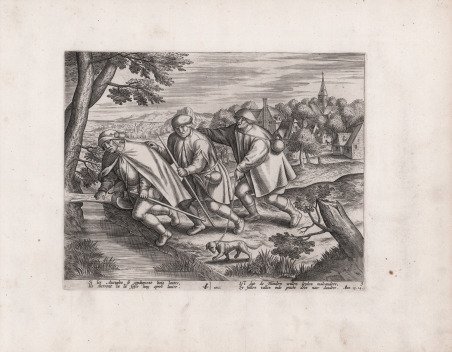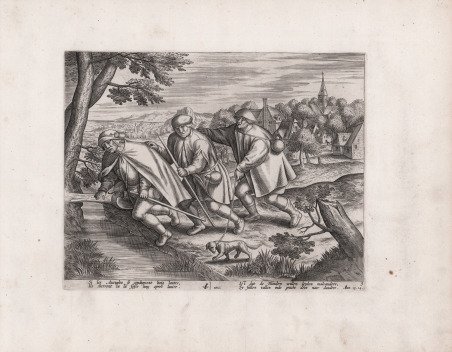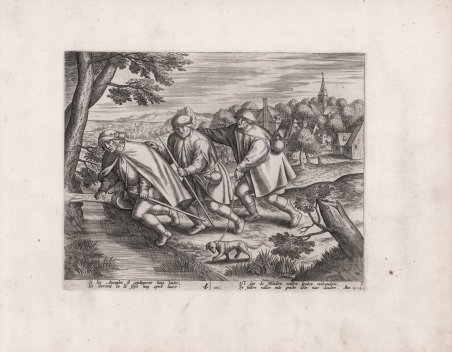Bulino, 1610/20 circa, in basso al centro l'excudit di Claes Janz. Visscher (CJV intrecciate). Sotto l'immagine una spiegazione in francese e in olandese e un riferimento al testo biblico di Matteo (15:14). Numerato 3, in basso a destra. Da un soggetto di Pieter Brueghel il Vecchio. L'opera traduce in immagini la parabola evangelica del cieco che guida un altro cieco, riportata da Matteo 15:14, in cui Cristo si rivolge ai ' Farisei: «Sono ciechi e guide di ciechi. E quando un cieco guida un altro cieco, tutti e due cadranno in un fosso!». Il cui significato è: quando l'incompetente consiglia altri incompetenti, le cose vanno male. L'acquaforte pubblicata da Claes Jansz. II Visscher è apparentemente ispirata a De parabel der blinden [La parabola del cieco], dipinta da Pieter Bruegel il Vecchio nel 1568. Questa ipotesi è stata avanzata dal Rijksmuseum, che conserva due impressioni di questa incisione. È incisa al contrario rispetto al quadro, e utilizza la stessa composizione: uomini ciechi, vestiti come vagabondi, seguono una linea diagonale attraverso il quadro, che porta a un fiume in cui cadranno presto; hanno mancato per poco un piccolo ponte di assi a monte, vicino a un albero. Come nel quadro, c'è un villaggio sullo sfondo. Tuttavia, ci sono solo tre ciechi invece dei sei del quadro di Bruegel, e quello di fronte, con la stessa ghironda del quadro sulla spalla, non è ancora caduto in acqua. Non descritto da Leeber, Bastealer e Hollstein. Il Rijksmuseum, che suggerisce una data del 1643 nella descrizione di una delle loro due impressioni, certifica che quest'opera è inserira dalla serie Theatrum Biblicum Hoc Est Historiae Sacrae Veteris et Novi Testamenti Tabulis Aeneis Expressae. Crediamo che una datazione più pertinente per l'opera sia tra il 1610 e il 1620 e che solo successivamente venga a far parte della Bibbia pubblicata da Claesz J. Visscher. L'incisore rimane anonimo, ma è possibile che si tratti dello stesso autore. Figlio di Jan Claesz Visscher, un incisore e editore di Amsterdam, padre di Nicolaes e nonno di Nicolaes II, fu attivo nella sua città natale dal 1601 fino al 1652. Nel 1605 lavorò come incisore per l'editore di Amsterdam Willem Jansz. Blaeu, realizzando tra l'altro alcune vedute dei più importanti monumenti di Amsterdam, e per Theodoor Galle. Molto presto però, Visscher iniziò a pubblicare stampe di propria fattura, caratterizzate dal logo del “pescatore”, riferimento al suo nome latino di Piscator. Immagazzinò, inoltre, stampe, acquisendo su larga scala lastre di rame da altri editori e stampatori, non solo prodotte da artisti viventi, ma anche vecchie tavole da Maarten van Heemskerck e altri noti pittori, prodotte da Hieronymus Cock e dai suoi successori. Contribuì, in questo modo, a costituire una delle più importanti case editrici dell'epoca. Rappresentò soggetti religiosi, paesaggi, in particolare invernali, e architetture, e realizzò stampe di devozione. Nonostante la più importante pubblicazione dell'epoca, la “Bibbia”, nella versione autorizzata nei Paesi Bassi, fosse senza illustrazioni, Visscher, come pure altri editori dell'epoca, realizzarono stampe, che, inizialmente separate dal testo religioso, vi furono in seguito incorporate. Bellissima impressione, su carta vergata coeva, con ampi margini, in perfetto stato di conservazione. ' Engraving, signed at the lower center with the excudit of Claes Janz. Visscher (CJV entwined). Beneath the image an explanation in French and in Dutch and a reference to the Bible text in Matthew 15:14. Numbered 3. After Pieter Brueghel the Elder. The blind leader is about to step into a ditch, taking his equally blind followers with him. The guide has a hurdy-gurdy under his cloak. A village can be seen in the background. The scene is a depiction of the proverb and parable: “if the blind lead the blind, both shall fall into a ditch”. The meaning of which is: when the incompetent advises other incompetents, things go wrong. The etching published by Claes Jansz. II Visscher is seemingly inspired by De parabel der blinden [The parable of the blind], painted by Pieter Bruegel the Elder in 1568. This hypothesis has been put forward by the Rijksmuseum, which keeps two impressions of this etching. It is etched in reverse compared to the painting, and uses the same composition: blind men, dressed like vagrants, follow a diagonal line across the picture, leading to a river in which they will soon fall; they narrowly missed a small plank bridge upstream, next to a tree. As in the painting, there is a village in the background. However, there are only three blind men instead of six in Bruegel's picture, and the one at the front, wearing the same hurdy gurdy as in the painting over his shoulder, hasn't fallen into the water yet. Not described by Leeber, Bastealer and Hollstein. The Rijksmuseum suggests a date of 1643 in the notice to one of their two impressions, this work is taken from the series Theatrum Biblicum Hoc Est Historiae Sacrae Veteris et Novi Testamenti Tabulis Aeneis Expressae. We believe that a more pertinent date for the work is between 1610 and 1620 and that it only later became part of the Bible published by Claes Jansz. Visscher. The engraver remains anonymous, but it is possible that it is the same author. Visscher, who was born and died in Amsterdam, was also known as Nicolas Joannes Piscator or Nicolas Joannis Visscher II, after his father who lived ca. 1550–1612. He learned the art of etching and printing from his father, and helped grow the family printing and mapmaking business to one of the largest in his time. It was a family business; his son Nicolaes Visscher I (1618–1679), and his grandson Nicolaes Visscher II (1649–1702) were also mapmakers in Amsterdam on the Kalverstraat. The times were with the Visschers for other reasons; due to the Protestant reformation, the older Bibles with their "Roman Catholic" illustrations were seen as outdated and apocryphal, but to liven up the new Protestant Bibles for the less well-read clergy, the Visschers produced illustrated maps and even landscapes of the places in the Bible. This became a very successful family business, with collaboration with many respected draughtsmen of the day. A new translation of the Bible was underway in the Netherlands, and until then, the new German translation done by Johannes Piscator, published in 1602–1604, was translated into Dutch. Though probably not a relative, his Bible translation was accepted by the Dutch Staten-General in 1602, which only lent more publicity and authenticity to the "Fisher" name. The trademark of the Visschers was a “fisherman”, after their name (thus the Latin nickname Piscator). A small fisherman would be strategically placed somewhere near water. If the subject was a landscape without a stream or pond, then often a figure walking with a fishing rod can be seen. Their map plates were reused for a century by other printers who unknowingly copied the entire plates, including the tell-tale fishermen. Observant scholars are thus able to trace the provenance of Bibles, maps, and landscapes from these signs. A fine impression, printed on contemporary laid paper, with margins, perfect condition. Cfr.



Découvrez comment utiliser
Découvrez comment utiliser

